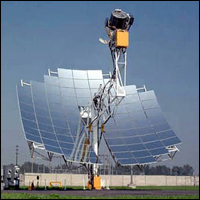The Ministry of New and Renewable Energy has released draft guidelines for selection of 1,500 MW grid-connected solar PV power projects under the second batch of Phase II of the National Solar Mission.
The draft guidelines propose the bundling scheme for implementation of the selected solar PV projects through NTPC Vidyut Vyapar Nigam Limited. The bundling scheme was adopted for implementation of 1,000 MW grid-connected solar PV projects in the first phase of NSM.
Under the bundling scheme, relatively expensive solar power is bundled with thermal power generated at NTPC’s coal fired power plants and provided to distribution companies at an affordable price. The thermal power bundled comes from the unallocated quota of the Ministry of Power. Since thermal power is cheaper in comparison, the bundling makes the price of the power supplied to the distribution companies affordable.
Grid-connected solar PV projects of 1,500 MW total capacity will be selected by NVVN and developed under the bundling scheme in the second batch of Phase II of the NSM. The selection of projects will be through a tariff-based reverse bidding process. NVVN will purchase power from the successful developers at their bid tariff and sell bundled power to distribution companies after adding trading margin. The NTPC subsidiary will enter into Power Purchase Agreement with developers and Power Sale Agreement with distribution companies.
As per the draft guidelines, the selection of the solar PV projects will be done in a phased manner so that no difficulties are faced in achieving financial closure. In FY 2014-15, solar PV projects of 750 MW will be selected (first tranche). The projects of remaining capacity will be selected in the next financial year (second tranche).
The draft guidelines stipulate that the minimum capacity of each project has to be 10 MW and the maximum up to 50 MW. The plant capacity will be in multiples of 10 MW.
The project developers will be invited by NVVN to participate in the Request for Selection process for installation of solar PV power plants on B-O-O basis. The RfS has to be submitted within 30 days from the date of invitation.
The total capacity of the solar PV projects allocated to a company, including its parent, affiliate, ultimate parent or group company, will be limited to 100 MW in each tranche.
Out of the total capacity of 1,500 MW, a capacity of 500 MW will be kept for bidding with Domestic Content Requirement. Under DCR, the solar cells and modules to be used in solar PV power plants should have been manufactured in India. Developers will have the option to either choose DCR or Open or both categories at the time of bidding.
The projects selected will have to be commissioned within 13 months from the date of signing of PPA. The commercial operation has to commence normally from 30 days from the actual date of commissioning or 1st of the subsequent month, whichever is later. The 25 year tenure of PPA will start from COD.
The NSM, launched in January 2010, has set a target for deployment of 20,000 MW grid- connected solar power capacity by 2022 in three phases (1,000 MW in Phase I up to 2012-13, 9,000 MW in Phase II from 2013 to 2017 and 10,000 MW in Phase III from 2017 to 2022).
Solar PV as well as solar thermal power projects with an aggregate capacity of 970 MW, in addition to 84 MW selected under the migration scheme, were selected in Phase I of NSM under the bundling scheme during 2010-11 (first batch) and 2011-12 (second batch) through a process of tariff based reverse bidding. A total capacity of 568 MW has been commissioned so far.
In the first batch of Phase II of NSM, grid-connected solar PV projects of 750 MW total capacity are being implemented through the Solar Energy Corporation of India with Viability Gap Funding support from the National Clean Energy Fund. The projects had been selected through reverse bidding on the VGF in two categories – DCR (375 MW) and Open (375 MW). The developers who emerged successful in the reverse bidding process signed PPAs in March this year. The projects are scheduled for commissioning within 13 months from the date of signing of PPA.











